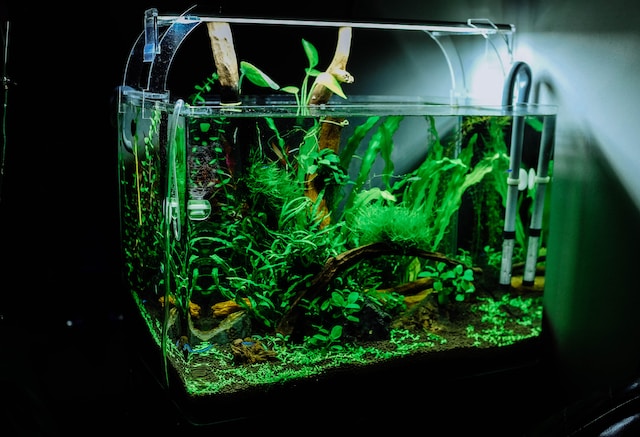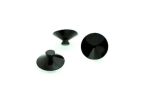Table of Contents
Are you considering taking the plunge into the wonderful world of fishkeeping? Setting up an aquarium is an exciting endeavor, but choosing the right tank size is crucial for the well-being of your aquatic friends. In this guide, we’ll explore the various factors you should consider when determining the best tank size for your starter aquarium.
From understanding aquarium sizes to the importance of making the right choice, we’ll cover it all so you can create a thriving and happy aquatic habitat.
Understanding Aquarium Sizes
Before we dive into the nitty-gritty of choosing the best tank size, let’s first grasp the concept of aquarium sizes. Fish tanks come in various dimensions, typically measured in gallons or liters.
The size you choose will significantly impact the type and number of fish you can keep, as well as the overall health of your aquatic ecosystem.
Importance of Choosing the Right Tank Size
Selecting the appropriate tank size is a crucial decision that should not be taken lightly. It goes beyond personal preferences and directly affects the well-being of the fish you plan to keep. Understanding the importance of choosing the right tank size is essential for any aspiring aquarium owner.
Impact on Fish Health
Fish are living beings, and their health and happiness should be a top priority for any responsible aquarium keeper. The size of the tank plays a significant role in the overall health of your fish.
In small tanks, fish can quickly become stressed and agitated due to limited space. Stressed fish are more susceptible to diseases and may exhibit abnormal behaviors such as aggressive tendencies or lack of appetite.
Additionally, the high concentration of waste in small tanks can lead to poor water quality, which further compromises fish health.
On the other hand, larger tanks provide ample swimming space and allow for the establishment of a more stable ecosystem. In a larger tank, the waste produced by fish is more effectively diluted, reducing the impact on water quality.
Fish in larger tanks tend to be more active, less stressed, and less prone to health issues, resulting in a more vibrant and enjoyable aquarium experience.
Maintenance Considerations
Another critical factor to consider when choosing the right tank size is the maintenance aspect. While setting up and maintaining a smaller tank might seem more manageable at first, it can quickly become overwhelming if not adequately maintained.
In small tanks, water quality can deteriorate rapidly, necessitating more frequent water changes and testing. The smaller volume of water makes it challenging to maintain stable conditions, requiring the use of high-quality filtration systems and close monitoring of water parameters.
On the other hand, larger tanks, though more stable in terms of water parameters, do require more effort when performing regular maintenance. Water changes can be more time-consuming, and filtration systems may need more attention.
However, with proper planning and a routine maintenance schedule, larger tanks can be a rewarding and manageable endeavor.
Best Starter Aquarium Sizes
Now that we understand the significance of selecting the right tank size let’s explore some of the best starter aquarium sizes along with their unique benefits:
Small Tanks
2.5 to 5 gallons (9.5 to 19 liters)
Small tanks are perfect for beginners with limited space and budget. They are easy to set up and maintain, making them an excellent choice for first-time fishkeepers.
These tanks are ideal for housing a single betta fish or a small school of nano fish, like celestial pearl danios or neon tetras.
However, it’s essential to note that the small volume of water in these tanks can lead to rapid fluctuations in water parameters, requiring more diligent monitoring and care.
Benefits:
- Affordability: Small tanks are generally more budget-friendly, allowing you to get started with fishkeeping without breaking the bank.
- Compactness: Ideal for small apartments or spaces with limited room for a larger setup.
- Low Maintenance: Cleaning and water changes are quicker and easier due to the small volume.
Medium Tanks
10 to 20 gallons (38 to 76 liters)
Medium-sized tanks strike a balance between the compactness of small tanks and the stability of larger ones. They provide more room for fish to swim and offer more options for stocking.
These tanks can accommodate a small community of fish, including schooling species or a few small to medium-sized fish. Properly maintained, a medium-sized tank can create a stunning display of aquatic life.
Benefits:
- Versatility: Medium tanks allow for more variety in fish selection, supporting a small community of compatible species.
- Stability: Compared to smaller tanks, these offer more stable water conditions, reducing the risk of sudden changes in parameters.
- Enhanced Aesthetics: With more space, you can add captivating decorations and create a visually appealing aquarium.
Large Tanks
30 gallons and above (113 liters and above)
Large tanks offer a truly immersive and captivating fishkeeping experience. They provide ample space for diverse fish populations and even allow for the inclusion of live plants and intricate decorations. While large tanks demand more investment, they offer the most rewarding experience for both you and your fish.
Benefits:
- Abundant Space: Large tanks accommodate numerous fish, promoting a harmonious community environment.
- Natural Environment: With enough room, you can simulate a more natural habitat, which can lead to healthier and happier fish.
- Easier Water Management: Larger volumes of water inherently offer more stable conditions, making it easier to maintain a balanced ecosystem.
Factors to Consider When Choosing a Tank Size
Type of Fish
The type of fish you want to keep in your aquarium is the primary factor to consider when determining the tank size. Different fish species have varying space requirements and behavior patterns, which directly impact the tank size needed for their well-being.
Some fish are small and can thrive in smaller tanks, while others are more active or grow to a substantial size, necessitating larger tanks to accommodate their needs.
For starters, it’s a great idea to opt for fish species that are considered beginner-friendly, such as Betta fish, Guppies, or Tetras. These fish are relatively small and can comfortably live in tanks as small as 10 to 20 gallons.
On the other hand, if you have your heart set on larger fish like Goldfish or Cichlids, you’ll need a much more substantial tank, typically around 30 gallons or more.
It’s important to research the specific fish you want to keep and ensure their needs align with the tank size you’re considering.
Available Space
The space available in your home or office is another crucial factor to keep in mind. While you may dream of having a massive aquarium, it’s essential to be realistic about the space you can allocate for it. Measure the area where you plan to place the tank and consider the dimensions of the tank you’re interested in.
Remember that you’ll also need to leave some room for maintenance and equipment, such as filters, heaters, and decorations.
If you have limited space, don’t worry! You can still create a beautiful and thriving aquarium with smaller tank options.
Nano tanks or desktop aquariums are becoming increasingly popular among beginners due to their compact size and ease of maintenance. These tanks typically range from 5 to 10 gallons and can be a perfect fit for small apartments or offices.
Budget
Your budget plays a significant role in determining the best tank size for your starter aquarium. Larger tanks generally come with higher upfront costs, as they require more materials, such as glass or acrylic, and often come with more advanced filtration systems.
Additionally, larger tanks may also lead to higher ongoing expenses, including increased water and electricity usage.
If you’re on a tight budget, smaller tanks can be a more affordable option. They often come as complete kits, including basic filtration and lighting systems, making them a cost-effective choice for beginners. As your experience and enthusiasm grow, you can always consider upgrading to a larger tank in the future.
Type of Aquarium Setups
Freshwater Aquariums
Freshwater aquariums are a popular choice for beginners due to their ease of maintenance and the wide variety of fish species available.
When it comes to choosing the best tank size for a freshwater aquarium, you have several options based on the type and number of fish you want to keep.
For a simple community tank with small schooling fish like Tetras or Rasboras, a 20 to 30-gallon tank can be an excellent starting point.
These smaller tanks are relatively easy to manage and offer enough space for a vibrant and lively aquatic community. If you prefer larger fish or want to keep multiple species, a 40 to 55-gallon tank provides more swimming space and allows for more diverse stocking options.
Saltwater Aquariums
Saltwater aquariums can be more challenging to maintain, but they offer a fascinating and visually stunning underwater world.
The best tank size for a saltwater aquarium depends on whether you want to keep fish-only or a reef system with corals and other invertebrates.
For a fish-only saltwater setup, a tank size of 30 to 50 gallons is a good starting point. This provides ample space for a few marine fish species without overwhelming you with the complexities of a larger tank.
However, if you’re interested in creating a vibrant reef environment with corals and other invertebrates, consider a larger tank of at least 75 gallons.
Larger volumes of water offer more stability and provide better conditions for the delicate balance required in a reef tank.
Tips for Maintaining Your Starter Aquarium
Regardless of the tank size you choose, proper maintenance is vital to ensure a healthy and thriving aquarium. Here are some essential tips to keep in mind:
- Regular Water Changes: Regularly changing a portion of the aquarium water is crucial for removing toxins and maintaining water quality. Aim for a 25% water change every 1-2 weeks, depending on your tank’s stocking level.
- Filtration System: Invest in a reliable filtration system that suits the tank size and type of setup you have. A good filter will help remove debris and keep the water clean and clear.
- Proper Feeding: Avoid overfeeding your fish, as excess food can lead to water pollution and health issues. Feed your fish in small portions and observe their eating habits to gauge the right amount.
- Monitor Water Parameters: Regularly test the water for pH, ammonia, nitrite, and nitrate levels. This will help you spot any potential issues early on and take corrective measures.
- Aquarium Lighting: Choose appropriate lighting for your aquarium, as it affects the growth of live plants and enhances the colors of your fish.
- Observe Fish Behavior: Pay attention to your fish’s behavior, as it can be an indicator of their health and well-being. Unusual behavior may be a sign of stress or illness.
By following these tips and staying dedicated to the care of your aquarium, you can create a beautiful and thriving underwater world for your fish to enjoy.
Conclusion
In conclusion, choosing the best tank size for your starter aquarium is a vital step in creating a successful and enjoyable fishkeeping experience. Consider the needs of your fish, the available space, and your budget when making your decision.
Whether you opt for a small, medium, or large tank, always prioritize the well-being of your aquatic friends. With the right tank size and proper care, you’ll create a mesmerizing underwater world that brings joy to both you and your finned companions. Happy fishkeeping!







